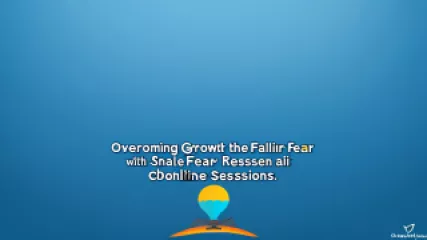10 Actionable Tips to Overcome the Fear of Failure in Online Sessions
10 Actionable Tips to Overcome the Fear of Failure in Online Sessions
Facing the fear of failure can be a daunting challenge, but with the right mindset and strategies, it's a hurdle that can be overcome. In this comprehensive list, we'll explore 10 actionable tips that can help you conquer your fear of failure in the context of online sessions, empowering you to achieve your goals and embrace new opportunities with confidence.
1. Reframe Your Mindset
The first step in overcoming the fear of failure is to reframe your mindset. Instead of viewing failure as a catastrophic outcome, try to see it as a learning opportunity. Failure is not the opposite of success; it's a necessary part of the journey. Each time you fail, you gain valuable insights that can help you improve and grow. Embrace this mindset shift, and you'll be better equipped to tackle challenges head-on.
2. Celebrate Small Wins
When you're working towards a big goal, it's easy to get caught up in the end result and overlook the progress you're making along the way. Make a conscious effort to celebrate your small wins. Recognize and acknowledge the steps you've taken, no matter how small they may seem. This will help boost your confidence and remind you that you're moving in the right direction, even if the journey isn't always smooth.
3. Develop a Growth Mindset
Closely related to reframing your mindset is cultivating a growth mindset. Believe that your abilities and skills are not fixed, but rather can be developed through dedication and hard work. Embrace challenges as opportunities to learn and improve, rather than threats to be avoided. This mindset shift will empower you to take risks, try new things, and view setbacks as a chance to grow, rather than a reason to give up.
4. Practice Self-Compassion
When faced with failure, it's easy to be overly critical of ourselves. Instead, practice self-compassion. Treat yourself with the same kindness and understanding you would extend to a close friend or loved one. Acknowledge your feelings, but don't dwell on them. Remind yourself that everyone experiences failures and setbacks, and that you're not alone in this journey.
5. Seek Support from Others
Surrounding yourself with a supportive network can be a powerful tool in overcoming the fear of failure. Reach out to friends, family, or even a therapist who can provide a listening ear, encouragement, and practical advice. Sharing your struggles and fears with trusted individuals can help you feel less alone and more empowered to face your challenges.
6. Break Down Your Goals
Large, ambitious goals can often feel daunting and overwhelming, fueling the fear of failure. Break down your goals into smaller, more manageable steps. This will make the path to success feel more attainable and less intimidating. As you check off each smaller goal, you'll build momentum and confidence, making the bigger picture feel more within reach.
7. Experiment and Iterate
Embrace a mindset of experimentation and iteration. Don't be afraid to try new approaches, even if they don't work out the first time. View each attempt as an opportunity to learn and refine your strategy. This iterative process can help you find solutions that are tailored to your unique needs and circumstances, ultimately increasing your chances of success.
8. Visualize Success
Visualization is a powerful tool that can help you overcome the fear of failure. Take time to imagine yourself successfully achieving your goals. Visualize the process, the obstacles you might face, and how you'll overcome them. This mental rehearsal can help you build confidence, reduce anxiety, and foster a positive, success-oriented mindset.
9. Practice Mindfulness and Relaxation Techniques
When the fear of failure takes hold, it can be accompanied by anxiety, stress, and negative thoughts. Incorporate mindfulness and relaxation techniques into your routine. Activities like meditation, deep breathing, or progressive muscle relaxation can help you manage these intense emotions, allowing you to approach challenges with a clear and centered mindset.
10. Celebrate Your Courage
Finally, remember to celebrate your courage. Acknowledging and applauding yourself for taking action, regardless of the outcome, is a powerful way to reinforce the progress you're making. Recognize that the act of trying, of facing your fears, is a victory in itself. This will help you maintain a positive, resilient mindset as you continue to navigate the journey towards your goals.
Overcoming the fear of failure is a journey, not a destination. By implementing these 10 actionable tips, you can develop the skills and mindset necessary to confront your fears, embrace new challenges, and unlock your full potential in online sessions and beyond. Remember, failure is not the end, but rather a stepping stone to growth and success.
Frequently Asked Questions: Overcoming the Fear of Failure
Q: What is the fear of failure, and why is it so common?
The fear of failure, also known as atychiphobia, is a persistent and often debilitating fear of experiencing failure or embarrassment. It's a common psychological phenomenon that stems from a variety of factors, including past negative experiences, perfectionist tendencies, and a desire to maintain a certain self-image or social status. This fear can hold people back from taking risks, pursuing their goals, and embracing new opportunities.
Q: How can the fear of failure impact someone's life and professional development?
The fear of failure can have significant consequences on an individual's life and professional development. It can lead to procrastination, avoidance of challenges, and a reluctance to take risks, ultimately limiting personal growth and career advancement. Those struggling with the fear of failure may also experience anxiety, low self-esteem, and difficulty making decisions, which can further hinder their ability to achieve their full potential.
Q: What are some common signs that someone is struggling with the fear of failure?
Some common signs that someone is struggling with the fear of failure include:
- Perfectionist tendencies: Constantly striving for flawless performance and being highly critical of any mistakes or shortcomings.
- Avoidance of challenges: Deliberately avoiding or procrastinating on tasks or projects that have the potential for failure.
- Excessive worry and anxiety: Experiencing persistent anxiety, worry, and rumination about the possibility of failure.
- Low self-confidence: Doubting one's abilities and feeling a lack of belief in their own potential for success.
- Difficulty taking risks: Reluctance to step outside of one's comfort zone or try new things due to the fear of failure.
Q: How can online sessions and counseling help individuals overcome the fear of failure?
Online sessions and counseling can be highly effective in helping individuals overcome the fear of failure. These virtual platforms provide a safe and accessible space for individuals to explore the root causes of their fears, develop coping strategies, and build the confidence and resilience needed to face challenges head-on. With the guidance of a qualified mental health professional, individuals can learn to reframe their mindset, develop a growth-oriented perspective, and cultivate the necessary skills to confront and overcome their fear of failure.
Q: What are some additional resources and support options for those struggling with the fear of failure?
In addition to online sessions and counseling, there are various other resources and support options available for those struggling with the fear of failure, including:
- Self-help books and online resources: Exploring books, articles, and online content that provide strategies and insights for overcoming the fear of failure.
- Support groups and communities: Connecting with others who share similar experiences and can provide mutual understanding and encouragement.
- Workshops and training programs: Participating in workshops or training sessions that focus on developing resilience, confidence, and a growth mindset.
- Coaching and mentorship: Seeking guidance and accountability from a coach or mentor who can help navigate the journey of overcoming the fear of failure.
Remember, the fear of failure is a common challenge, but with the right support and strategies, it can be overcome. By embracing a growth mindset, practicing self-compassion, and seeking the help of professionals and resources, individuals can unlock their full potential and thrive in the face of adversity.
Conclusion: Embrace Your Power to Overcome the Fear of Failure
The fear of failure is a formidable obstacle, but it is one that can be conquered. By implementing the 10 actionable tips outlined in this article, you can cultivate the mindset, strategies, and support needed to overcome this challenge and unlock your full potential in online sessions and beyond.
Remember, failure is not the opposite of success; it's a necessary part of the journey. Embrace a growth mindset, celebrate your small wins, and practice self-compassion as you navigate the path towards your goals. With the right mindset and the support of others, you can confront your fears, learn from your experiences, and emerge stronger and more resilient than ever before.
Embarking on this journey to overcome the fear of failure may not be easy, but the rewards are truly transformative. Unlock your full potential, embrace new challenges, and celebrate your courage as you take the steps towards a future where failure is no longer a source of dread, but rather a catalyst for growth and success. The power to overcome the fear of failure lies within you; all you need to do is take that first step forward.






